In September, my husband, Jake, fell to his death on his favorite mountain, the North Twin Sister. My geologist friend Jackie tells me that the Sisters Range is a rare outcropping of the earth’s mantle; the olivine rock a distinctive rusty hue.
Mountains were as necessary as air for Jake, and he’d summited this one dozens of times. Every year, he bought a key to the logging company gate, granting access to five more miles of road, bringing the wild terrain closer to home.
Jake was widely considered to be conservative about risk, and many in our community reacted to the news of his accident with disbelief. How could this have happened to Jake? And—unspoken—if it can happen to Jake, then could it happen to me?
I was the person who waited for Jake to come home, and over the years, I pushed him to take responsibility for the risks. Between Jake’s adventures, we prepared, and I’ve come to think of this preparation as an act of love, which made our tragedy easier to navigate and less traumatic. We mourn Jake’s loss, but I feel no resentment or regret, and I don’t have to uproot my kids and sell my house.
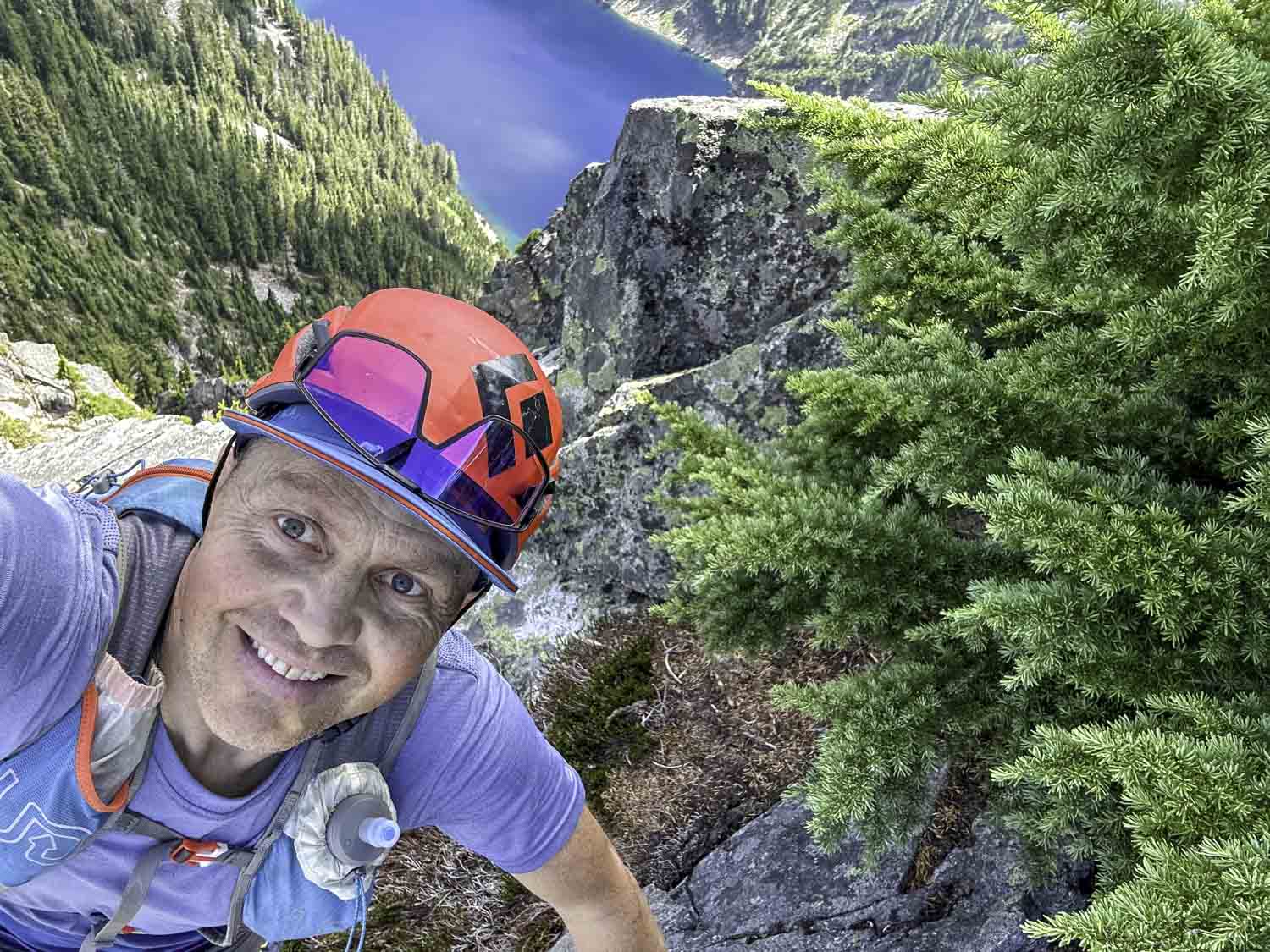
I don’t want to hyperbolize the risk of adventuring compared with other risks we take: driving on the freeway, owning a swimming pool, sitting on the couch. Adventures deliver physical and mental health benefits, which usually far outweigh the risks.
Part of being adults, however, is taking responsibility for our choices. Here are the lessons learned as someone with a lot of experience waiting for an adventurer to return home.
Designate Beneficiaries and Sign Those Documents
Jake left a signed durable power of attorney, healthcare directive, and a will. If you are an adult, the first two are a minimum and will relieve your loved ones of having to guess your wishes if you are incapacitated. If you have people who depend on you and/or you have assets, write a will.
Designating beneficiaries on financial accounts makes distribution easier, especially if the beneficiary is your spouse. Jake’s accounts were in good order, but one account with no beneficiary triggered probate. Another designated our kids, requiring that I open a special type of account for non-spouse beneficiaries, creating extra paperwork.
If you have dependents, buy sufficient life insurance with a reputable company, make sure that premium gets paid, and keep a copy of your policy. Then tell your people where to find these documents.
Don’t put your loved ones in a financial crisis, having to move to different housing, or worse, while they are mourning your death.
Communicate Your Plans
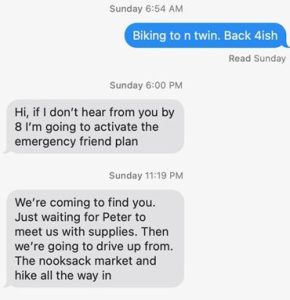 Years ago, the first time I stayed up late waiting for Jake to return from some unknown adventure, I was angry when he walked in the door. I had wondered if I should call 911, but I worried I’d just be overreacting and feel silly. I resented the burden of inventing an emergency plan late at night while home alone with our kids.
Years ago, the first time I stayed up late waiting for Jake to return from some unknown adventure, I was angry when he walked in the door. I had wondered if I should call 911, but I worried I’d just be overreacting and feel silly. I resented the burden of inventing an emergency plan late at night while home alone with our kids.
I remember Jake emphasizing that calling for official Search and Rescue (SAR) should never be plan A. “My friends will find me much faster,” he said.
After that day, Jake sent me a text message before each adventure with four points.
- Destination and planned route
- Expected return time
- The time when I should call emergency response
- Name and phone numbers of people I should call for emergency response
With this simple habit, Jake took responsibility for key decisions around his own search and rescue response.
The morning of his death, Jake’s text to me read, “Biking to n twin. Back 4ish”. It contained only the first two points but was gold that night.
A hiker found Jake’s iPhone 100 meters uphill from the location of his body. Had he been injured but conscious, he still would not have had access to the phone’s satellite SOS feature. Only an inReach device passively transmitting his location at a regular interval would have alerted us that he was stopped and given us his location.
Make an Emergency ‘Plan A’
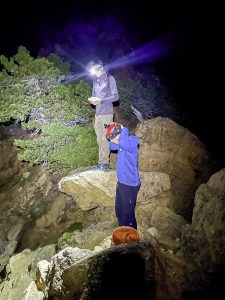
I knew from previous adventures that his friends Peter Lillesve and Ingmar Prokop would be the “who” for emergency response. At 7 pm, I called Ingmar, and we drove to the West Ridge trailhead. We saw no sign of Jake on the drive in but found Jake’s bike at 9 pm at the start of the climber’s trail. We texted Peter from Ingmar’s inReach and asked him to call 911. The message took 10 minutes to transmit.
Had Jake and I not made an emergency plan, had I just called 911 and waited, or driven to the trailhead alone, or had to stay home with small kids, I can only imagine the frustration and helplessness I would have felt that night and the regret I might feel now.
Instead, Peter, Ingmar, and I became a team. At midnight, we began the hike in, ready to keep Jake’s spirits, hydration, blood sugar, and body temperature up through the night with gummy bears, Coke, mini donuts, and sleeping bags.
After reaching the summit at 3 am, Peter returned to our makeshift camp at daybreak and called 911 again. Shortly after, we had our first contact with the SAR deputy, 10 hours after our initial call.
Understand how Official Search and Rescue Works
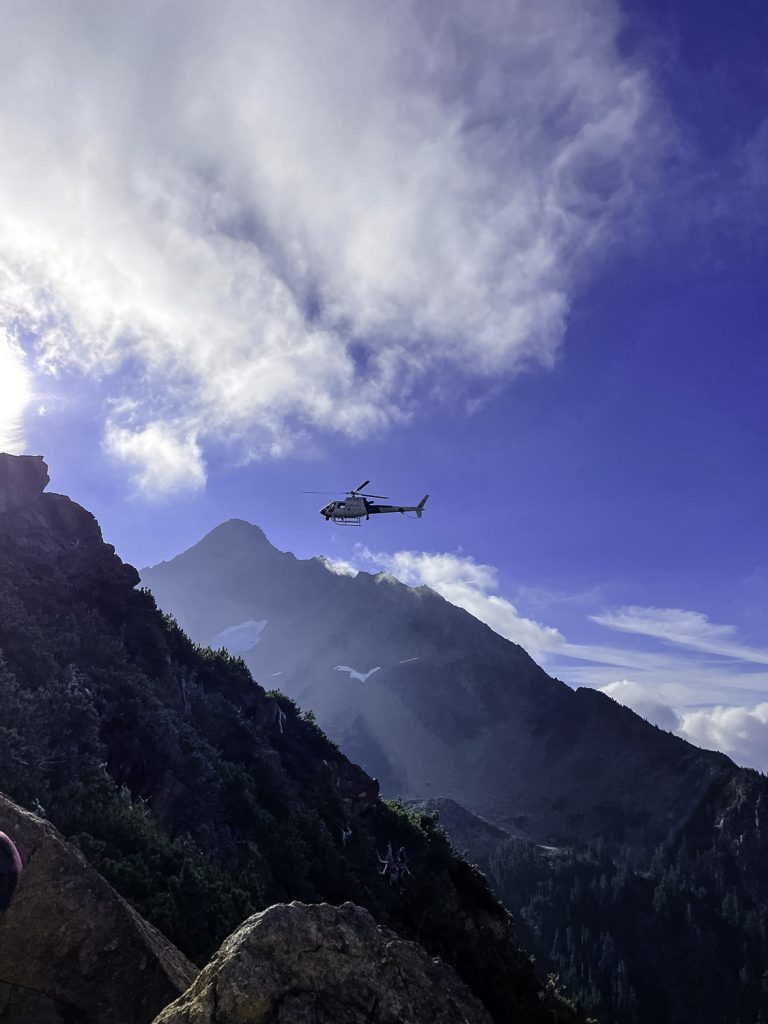
Photo courtesy Beth Hartsoch
Official SAR practices vary by location, so it’s important to be familiar with your local SAR structure. A rescue is initiated by calling 911 or activating the SOS feature on a satellite emergency notification device (like Garmin inReach). Expect to receive further calls once you make the initial call, so the ability to answer the phone is essential.
Dispatch will ask for GPS coordinates, severity of injury, medical history, familiarity with the terrain, and equipment available on scene.
When Whatcom’s dispatch receives a SAR request, they route it to the SAR sheriff’s deputy on duty. SAR deputies triage requests based on factors like the missing person’s experience level, medical history, familiarity with the terrain, the weather, and the scope of the search area. They may decide against activating a SAR team, but they will call back within an hour. If the SAR deputy hasn’t called, no response is underway.
The night we searched for Jake, the deputy declined to activate a SAR team. Unfortunately, we never received this message. At first, this affected our decisions; we assumed we’d talk with SAR before the next step. We decided to hike the West Ridge Trail after the wait passed an hour.
Adulting First, Adventuring Second
Jake fell 250 vertical feet and died almost instantly. He did not suffer, and so these lessons can be learned without the nightmares and regret that would have plagued me if he had. Not everyone is so lucky.
Work with the people who await your return from adventures to mitigate the risks to their well-being. Organize your financial life, communicate your plans, make a SAR plan A, understand how official SAR works, and give your loved ones the gift of knowing how to look for you.
Then go and be alive in the world.
Ingmar Prokop, Peter Lillesve, and Julianna Safstrom contributed to this story.
 Beth Hartsoch is a city kid who tries to be brave on outdoor adventures. She wrangles data at her day job and has a mixed record on parenting teenagers, riding bikes, and civic engagement.
Beth Hartsoch is a city kid who tries to be brave on outdoor adventures. She wrangles data at her day job and has a mixed record on parenting teenagers, riding bikes, and civic engagement.
 AdventuresNW
AdventuresNW




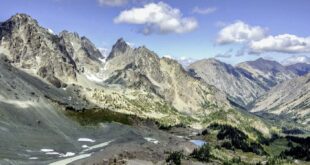

Thank you for sharing this Beth it means a lot.